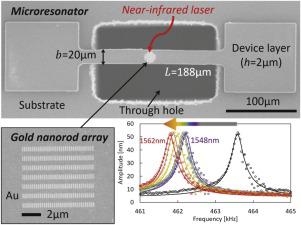Sensors and Actuators A: Physical ( IF 4.1 ) Pub Date : 2020-09-16 , DOI: 10.1016/j.sna.2020.112337 Koji Sugano , Yuki Tanaka , Akio Uesugi , Etsuo Maeda , Reo Kometani , Yoshitada Isono

|
This study presents a micromechanical resonator to detect near-infrared (NIR) laser wavelength shifts for dense wavelength division multiplexing (DWDM) systems. A feedback control of laser wavelength detecting the wavelength shift is required to keep a spacing of adjacent wavelength channel. The conventional detection method with an etalon filter has the detectable limit of wavelength shift. In this regard, we integrate a micromechanical resonator with plasmonic gold nanorod structures to produce the optical absorption change due to the wavelength shift. The wavelength shift can be detected via the resonant frequency shift based on the thermal stress change in the resonator. The gold nanorod array is fabricated on a gold thin film and subsequently covered by a Si thin film, which is used for controlling the refractive index of the surrounding medium. This causes absorption peaks of plasmonic resonance to be generated in the NIR region. We develop a theoretical equation for the relative resonant frequency that is in proportion to the laser intensity and the beam length cubed. The experimental tendency of relative resonant frequency shifts is observed to be in good agreement with the theoretical equation. The maximum relative resonant frequency shift is 69 Hz/nm, whereas the resolution is estimated to be 0.37 pm, taking into account the thermomechanical noise. Therefore, the fabricated resonator is confirmed to be useful for measuring the laser wavelength with high resolution for large-capacity DWDM systems.
中文翻译:

基于机械微谐振器的传感器(以含硅的金纳米棒作为光吸收剂)检测近红外激光的波长偏移
这项研究提出了一种微机械谐振器,用于检测密集波分复用(DWDM)系统的近红外(NIR)激光波长偏移。需要激光波长检测和波长偏移的反馈控制,以保持相邻波长通道的间距。使用标准具滤光片的常规检测方法具有波长偏移的可检测极限。在这方面,我们将微机械谐振器与等离子金纳米棒结构集成在一起,以产生由于波长偏移而引起的光吸收变化。可以基于谐振器中的热应力变化,通过谐振频率偏移来检测波长偏移。将金纳米棒阵列制造在金薄膜上,然后用Si薄膜覆盖,用于控制周围介质的折射率。这导致在NIR区域中产生等离子体共振的吸收峰。我们为相对谐振频率开发了一个理论方程,该方程与激光强度和立方光束的长度成正比。观察到相对共振频率偏移的实验趋势与理论方程式非常吻合。考虑到热机械噪声,最大相对共振频率偏移为69 Hz / nm,而分辨率估计为0.37 pm。因此,证实了所制造的谐振器对于大容量DWDM系统的高分辨率激光波长的测量是有用的。我们针对相对谐振频率开发了一个理论方程,该方程与激光强度和立方光束的长度成正比。观察到相对共振频率偏移的实验趋势与理论方程式非常吻合。考虑到热机械噪声,最大相对共振频率偏移为69 Hz / nm,而分辨率估计为0.37 pm。因此,证实了所制造的谐振器对于大容量DWDM系统的高分辨率激光波长的测量是有用的。我们为相对谐振频率开发了一个理论方程,该方程与激光强度和立方光束的长度成正比。观察到相对共振频率偏移的实验趋势与理论方程式非常吻合。考虑到热机械噪声,最大相对谐振频率偏移为69 Hz / nm,而分辨率估计为0.37 pm。因此,证实了所制造的谐振器对于大容量DWDM系统的高分辨率激光波长的测量是有用的。考虑到热机械噪声,最大相对共振频率偏移为69 Hz / nm,而分辨率估计为0.37 pm。因此,证实了所制造的谐振器对于大容量DWDM系统的高分辨率激光波长的测量是有用的。考虑到热机械噪声,最大相对共振频率偏移为69 Hz / nm,而分辨率估计为0.37 pm。因此,证实了所制造的谐振器对于大容量DWDM系统的高分辨率激光波长的测量是有用的。











































 京公网安备 11010802027423号
京公网安备 11010802027423号